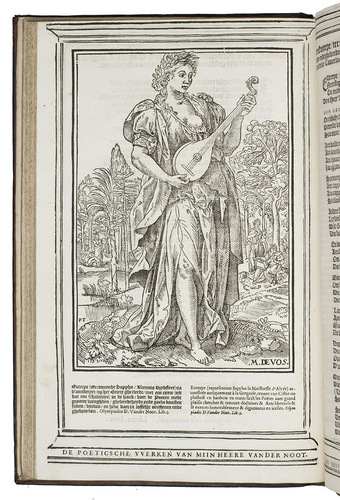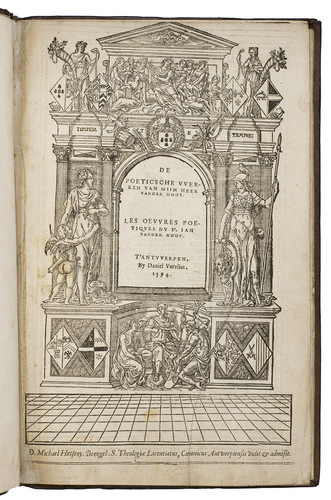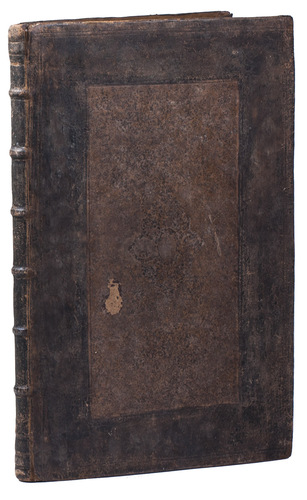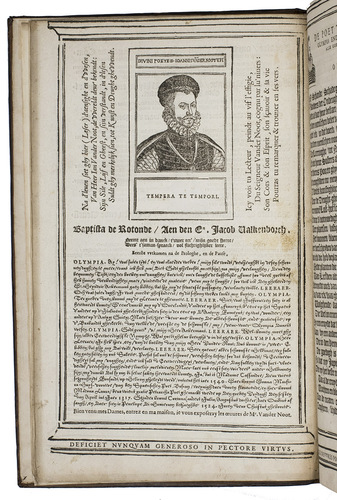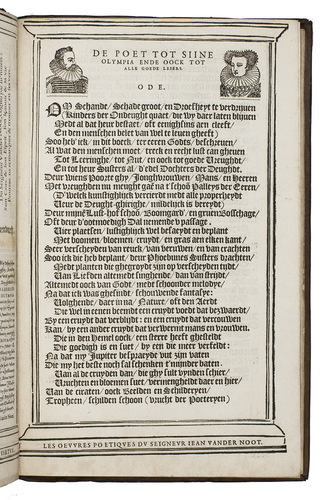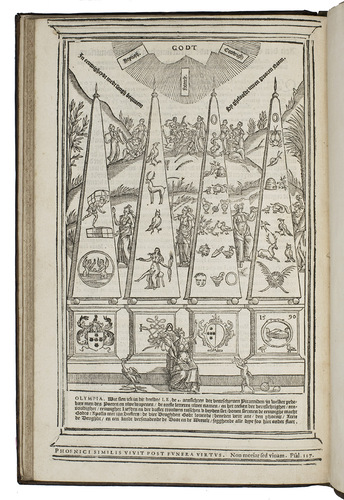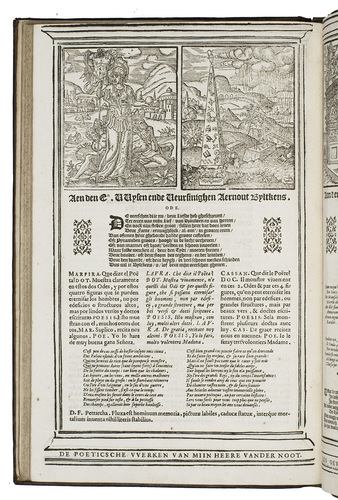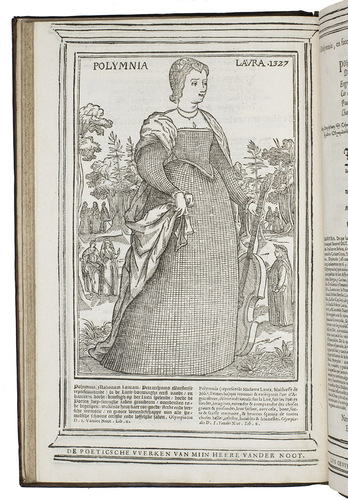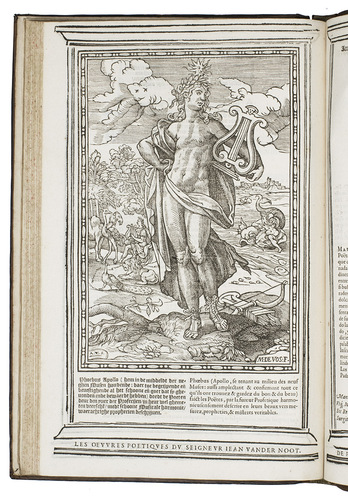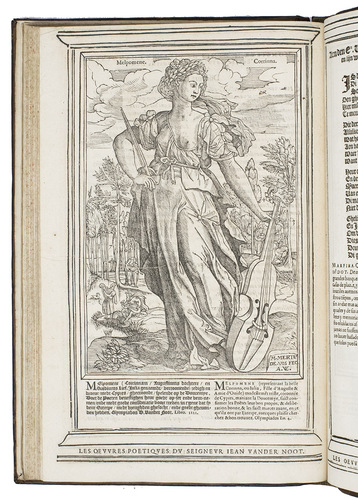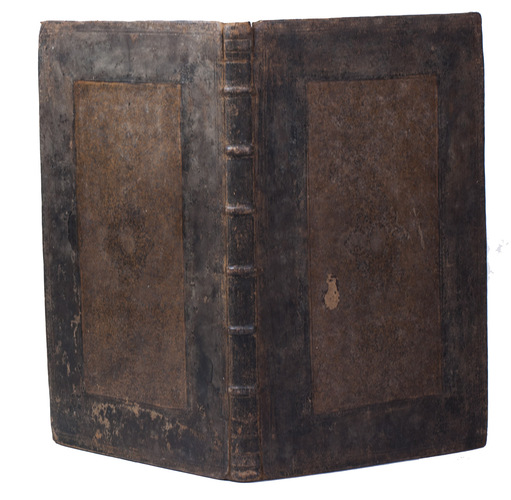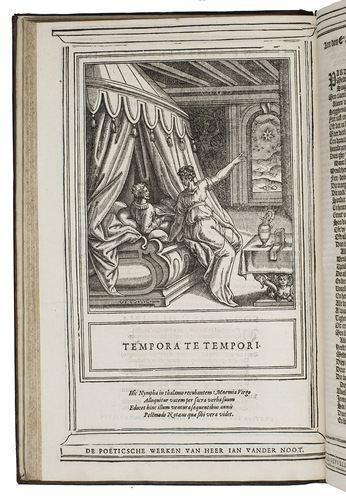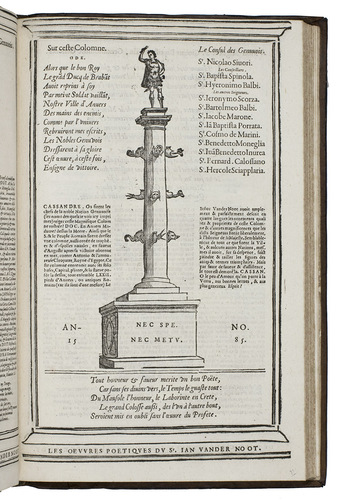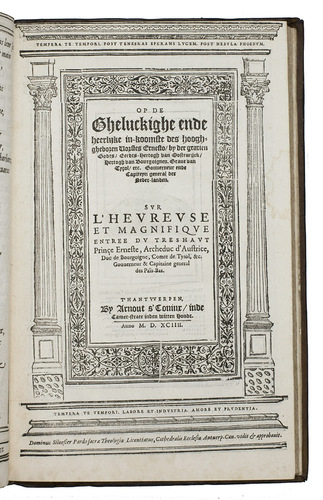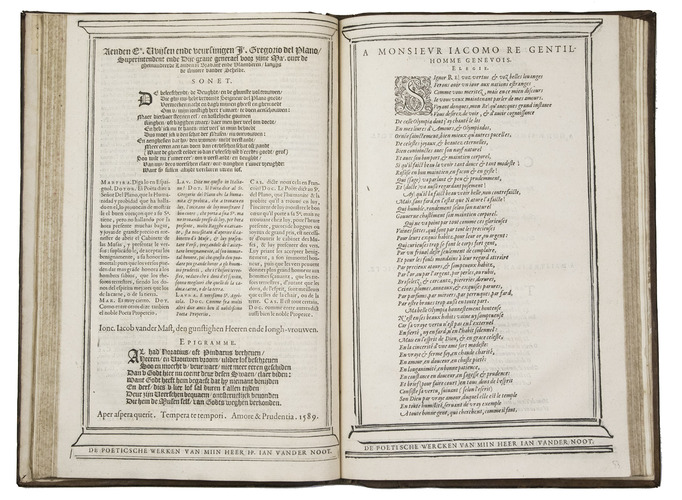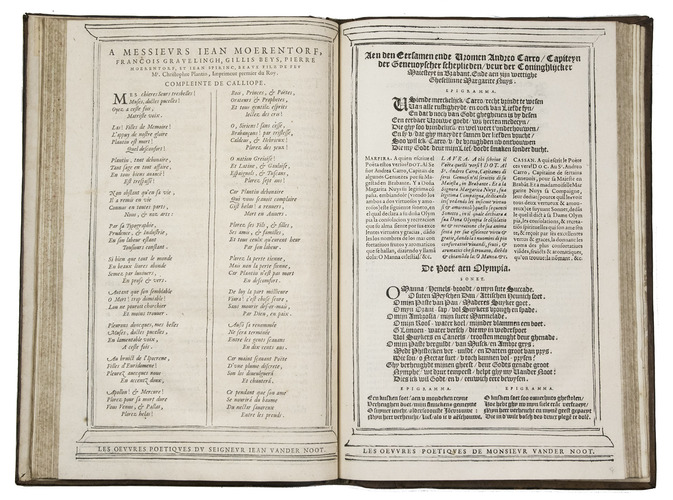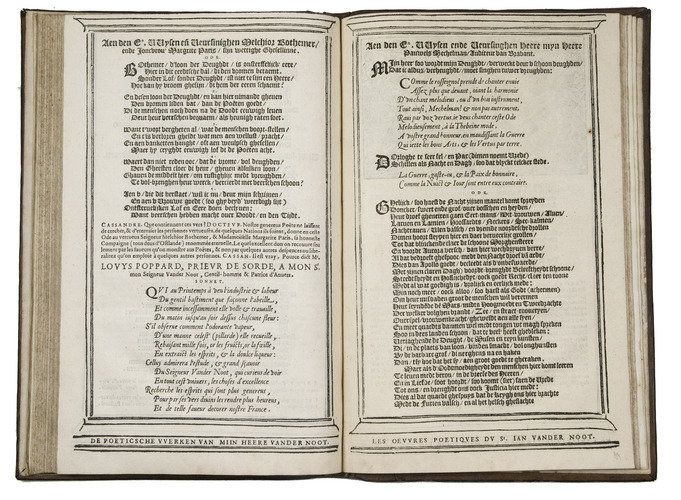NOOT, Jan van der.
De poeticsche werken van mijn Heer vander Noot. Les oeuvres poetiques du Sr. Jan vander Noot.
Antwerp, Daniel Vervliet and Arnout Coninx (shared printing), "1594" [=1588-1595]. Folio. With the general title-page bearing Vervliets 1594 imprint, the only part-title (for the Inkomste bifolium) bearing sConincxs 1594 imprint, 7 small bust portraits, 2 portraits of the author, 10 small rectangular illustrations, 2 medium illustrations and 8 full-page illustrations (on integral leaves), all woodcut, some (and the 2 title-pages) in architectural and/or arabesque woodcut frames. The text is variously set in 1, 2 or 3 columns, sometimes even mixing them on one page, each page in a frame (made partly from rules) and with the running titles in Dutch and French at the foot of the page. An occasional bifolium includes a woodcut decorated initial. The text, in Dutch, French, Spanish, Italian, German, Latin, and Greek, is set in dozens of roman, italic, textura, civilité, fraktur and Greek printing types plus interlaced typographic capitals and arabesque typographic ornaments. Blind-tooled calf (ca. 1725/30?) by the so-called "Minnewit" bindery in Amsterdam, sewn on 6 supports, each board with two double-fillet frames, the inner field sprinkled and the outer field blackened, with a large centrepiece and 2 different corner pieces, the smaller inside and the larger outside each corner of the inner frame, headbands in red and green, red sprinkled edges, plain endpapers. [102] ll.
€ 35,000
The most complete set known of the extremely rare series of laudatory poems - in Dutch, French, Italian, Spanish, German and Latin - written by the Dutch Renaissance poet Jan Baptista van der Noot (1539-post 1595). Van der Noot had each of his poems in the Poeticsche werken printed as a 4-page folio, so a single bifolium per poem (with one exception that required two bifolia). The author himself assembled these in different collections as circumstance, opportunity and his own interest dictated, issuing them with a preliminary bifolium that included a dated title-page and sometimes a second preliminary bifolium. As a result, no two copies are the same. Larger collections, like ours, were most likely compiled for and/or commissioned by very wealthy bibliophiles. They were interested not only in the contents of the poems - which serve primarily to praise them and/or their relatives and prominent acquaintances and at the same time show off the authors stylistic and rhetorical skill - but also in the decorative aspects of the work, which explains the wide variety of highly decorative pages including many woodcut illustrations.
The present collection comprises the series of poems printed and published in Antwerp in the years 1588 to 1595 by Daniël Vervliet and Arnout s'Conincx (or Coninx), some bifolia by Vervliet and others by sConincx. Gillis van den Rade, also in Antwerp, had published an earlier and completely different series of Van der Noot poems from 1580 to 1587.
Vervliet and s'Conincx produced 61 bifolia for the present series, thoroughly catalogued by Waterschoot (we refer to the bifolia using his code-names), but the author never intended all of them to appear together. They appeared over a period of eight calendar years (1588 to 1595), and during that time Vervliet and sConincx printed five different dated general title-pages, three of the five with the date changed during the press run to make title-bifolia for the present and for the coming year. A second bifolium of preliminary matter was printed only once. One poem apparently ran short, for Vervliet and sConincx printed it three times, and one poem proved too long for a bifolium, so it appears in a single 4-leaf quire. So, the most extensive set one could have with no duplication would comprise 55 bifolia: the title-bifolium, the second preliminary bifolium and 52 poems on 53 bifolia. No such copy is known and perhaps none ever existed, but the present volume comprises 51 bifolia: the title-bifolium, 2nd preliminary bifolium and 48 poems on 49 bifolia (including the last printings of the title-bifolium and the Weerdt/VVeerdt bifolium (title-bifolium 1593-1594 - ours with the date 1594- and VVeerdt 1593). So, the set lacks only 4 bifolia with 4 poems. This is the most extensive set known: only two others come close, with 49 (at City Library in Antwerp) and 46 (Royal Library in Brussels) bifolia, and the most extensive sets after those have only 27, 26 and 24 bifolia; one set has only 2 bifolia. Van der Noots Poeticsche werken - whether the Van den Rade or the present Vervliet/sConincx series - almost never appear on the market.
Van der Noot, one of the most prominent poets in the Southern Netherlands during the Renaissance, wrote in the style of French poets like De Ronsard and Du Bellay. Even though he was born to a noble Catholic family, he played a leading role in the 1567 Calvinist revolt in Antwerp. This forced him to flee to England, where one year later he published Het theatre oft toon-neel - which also appeared in French and English - a collection of short poems: some translations of works by Petrarch, Du Bellay and others and some original poems by Van der Noot himself, all with prose commentaries attacking the Catholic church. Van der Noot's personal motto "Tempera te tempori" (adapt yourself to the time) proved to be quite appropriate when he later returned to Antwerp and even, as needs must, returned to the Catholic church. His most notable works, including the Poeticsche werken, were published in Antwerp, including: Cort begryp der XII. boeken Olympiados ... (1579) and Lofsang van Braband ... (1580). He is also credited with introducing the sonnet into Dutch literature, paving the way for the illustrious 17th-century Dutch poets Constantijn Huygens and Jacob Cats.
More information and a full list of the contents of the present copy are available upon request.
The bifolium Chefs [2] is quired in Chefs [1] to make a quire of 4 as intended, but three other pairs of bifolia have been inappropriately quired: Arnesto in Inkomste, Farneze in Sterckheyt and Euterpe in Langhart. With a small bookplate (ca. 1860/90?) on the front paste-down: "Bibliothèque V[ict]or Quénescourt". With a professionally restored tear in the title-page, and a small stain in 1 leaf, but otherwise internally in very good condition. The binding is rubbed, and the chemicals that the binder used to blacken the spine and outer field of the boards have caused superficial damage, but the binding remains structurally sound and the tooling within the central fields remains clear. Belg. typ. 4631; Iberian books 19054-19062; Palau 351519; Peeters-Fontainas 842; Pettegree, French vernacular books, 50378-50384; STCN 385907680 (1 copy with 17 bifolia (1590), mistakenly(?) described as 8vo); STCV 12925589, 12925593, 12925600 (3 copies with 3 (1588), 19 (1592) & 4 (1594) bifolia); USTC 79811, 79816, 80797-80799, 80880, 83007, 349442-349444, 349930, 350699, 440595, 443357 (several of the "24" copies listed are multiple entries for the same copies, 3-20 or 21 bifolia, in spite of erroneous records of "182" leaves); W. Waterschoot, ed., De "Poeticsche werken" van Jonker Jan van der Noot. I. Analitische bibliografie, PW 1588-1595 on pp. 64-170 (21 copies with 2-49 bifolia); WorldCat 68782943, 902545995, 1153618208, & possibly others (at least 5 copies); for the author: Vermeylen, Leven en werken van Jonker Jan van der Noot (1899).
Related Subjects:

















